How to reach here:
By Air: The nearest airport is at Bhuj, which is around 70 km from Kutch and is connected directly connected with cities like Ahmedabad and Mumbai.
By Rail: Adipur is the nearest railway station for people travelling to Kutch. The station is directly linked with cities like Mumbai (Kutch Express) and Ahmedabad (Ala Hazrat Exp).
Best time to visit: October to February.
Languages spoken: Kutchi, Gujarati, Sindhi, Hindi.
Must eat: Khichdi,Kadhi,Khaman Dhokla, Doodhpak,Shrikhand,Bajra-ki-roti.
Famous Restaurants: Green Rock, Noorani Mahal,Jesal,Zoraba the Buddha,Green Hotel.
Places you must visit:
Bhuj is a city situated in the Kachchh district of Gujarat. It is a municipality town as well as the district headquarters of Kachchh. The city is famous for its Hindu temples, palaces and wooden pavilions. The houses of Bhuj are decorated with mud and mirrors on both the interiors and exteriors. Bhuj is also home to the oldest museum of Gujarat. It is also distinguished for its handicraft and embroidery. The bandhani and batik textiles along with silk embroidery on leather are the specialities of the place. It is also known for its enamel work done on gold and silver jewellery, seashell toys, lacquered wood and metal bells. The name of the city is derived from the name of the Bhujia Fortress, which is present at a nearby hill and provides a complete view of the city. The history of Bhuj belongs to the period of Naga Chieftain. Its history has experienced the social upcoming of the Indus Valley Civilization along with the exile period of Pandavas and political invasion of Alexander the Great. A local ruler Maharoa Hamir founded this city in 1510. It was declared the capital in 1549 during the rule of Rao Khengarji I. During the British rule, the city was an independent part of the Princely States and after independence, it became a part of India.
Places to visit in Bhuj:
Kutch Desert Wildlife Sanctuary is spread over san area of about 7505.22 sq. km.This wildlife sanctuary is considered as one of the largest seasonal saline wetland areas. It has a water depth that ranges between 0.5 to 1.5 m and preserves various species of flamingo or greater flamingo birds.The sanctuary comprises two hills Kala Dungar and Goro Dungar along with agricultural land, barren wasteland, grassland, village ponds, irrigation reservoir and scrubland. Different scrubs like gugal, gorad, kerdo, prosopis chilensis, bokhano, hermo baval, mithi jar and khijado can also be found in this sanctuary. This area is also rich in fauna such as greater flamingo, Indian porcupine, spiny tailed lizard, black-necked storks, wild ass and Indian cormorant.



Narayan Sarovar Sanctuary is also known as Narayan Sarovar Chinkara Sanctuary. This sanctuary covers an area of about 444 sq. km. and is one of the distinct eco-system in the Kutch district of Gujarat state. The sanctuary mostly comprises scrub forests, desert thorn forests, dry savannah-type vegetation and seasonal wetlands.It is a home to number of mammals such as chinkara, the endangered Indian wolf, wildcats, desert foxes, honey badger and wild boar. Tourists can also see around 184 distinct species of birds in this sanctuary including waterfowl, black partridge, houbara bustard, lesser florican and great Indian bustard. Around 252 kinds of plants can be found in the sanctuary like gorad, babul, kerdo and more.
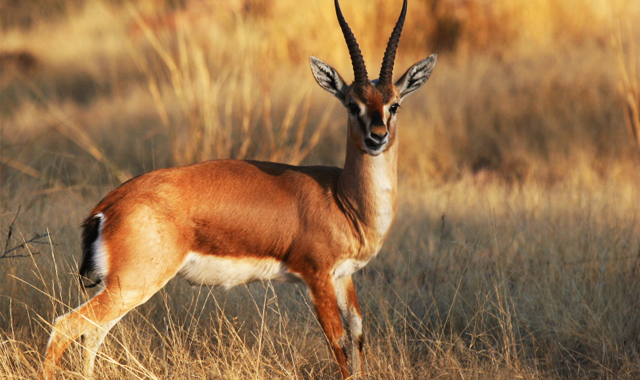
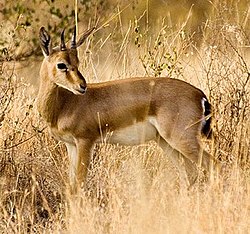
Prag Mahal palace was built in 1879 and it took 10 years for the completion of its construction. It is constructed using sandstone and Italian marble. The structure of the palace has beautiful Jali work and Corinthian pillars that are carved with European animals and plants. Rao Pragmalji II and Colonel Henry Saint Wilkins were the architects, who designed the palace in European and Indian Gothic style.

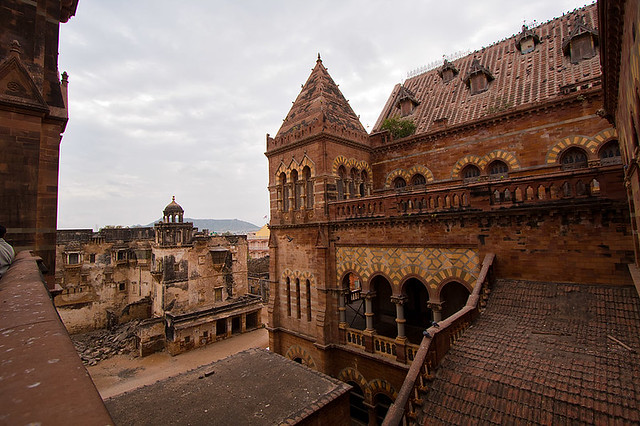

Aina Mahal is one of the ancient palaces constructed during the 18th century in the city of Bhuj. This palace was built by Maharao Lakhpatji, which in recent time has turned into a museum. His passion for art, literature, architecture and music led to the creation of this architectural Ramsinh Malam, a craftsman, converted the royal dream into a reality in the form of this palace. It serves as a chief tourist attraction because of its design and layout. The palace is a two-storey building which comprises pleasure pool, darbar hall and suites that belong to the members of royal family. The palace has a hall which is full of mirrors and thus, it is called Aina Mahal.Ramsinh was well versed with the European style of architecture, which the palace exhibits. Due to his long stay of 17 years in Europe, he learnt the local art and style. The walls of the palace are covered with gilded ornaments, white marbles and mirrors. Apart from this, the floor of the hall has tiles with a podium over it, which is surrounded by several fountains. A chandelier made of Venetian glass in the hall is the prime attraction of the palace.






Indian Wild Ass Sanctuary is a well known wild ass sanctuary located within the borders of Rann of Kutch in Gujarat. The wildlife sanctuary is spread over an area of 4,953 sq. km. and provides protection to more than 2,100 rarely found wild asses.Birds like falcons and houbara bustard and reptiles like lizards and snakes can also be seen in the sanctuary. Trekking, birdwatching and ride on camouflaged boats are some of the popular activities that tourists can enjoy in this sanctuary.

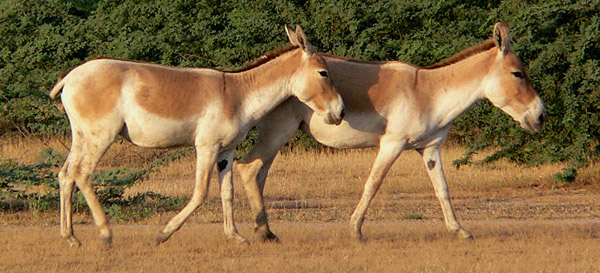
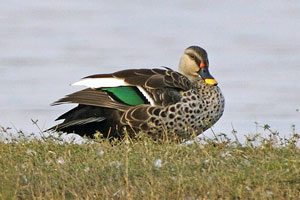
Kutch Bustard Sanctuary is one of the prominent wildlife sanctuaries in the Kutch district of Gujarat state. It was declared as a sanctuary in 1992 and is spread over an area of 2 sq. km. The sanctuary is a home to several endangered species like wolf, chinkara and lesser florican. Besides, mongoose, blue bull, sand grouses, jackal, hyena, royal snake and great Indian bustards can also be spotted in the sanctuary.


Banni Grasslands Reserve is situated on the southern edge of Rann of Kutch in Kutch District. It is spread over an area of 3,847 sq. km. and has a rich biodiversity and wildlife. This reserve has been declared with the status of Protected or Reserve Forest in India.The reserve is inhabited by several mammals like nilgai, blackbuck, caracal, golden jackal, wild boar, chinkara and Asiatic wildcat. Moreover, this reserve has been classified as the last remaining habitats of cheetah.


Chari-Dhand Wetland Conservation Reserve is situated on the edge of Banni Grasslands in Kutch District of Gujarat. It is a seasonal desert wetland, which covers an area of 80 sq. km. and is situated in the south-west of Bhuj. Around two hundred species of birds including endangered and migratory birds flock in the area especially during monsoons and winters. The Gujarat State Forest Department has given this reserve as the status of Protected or Reserve Forest in 2008.This reserve is declared as one of the largest seasonal wetlands, where tourists can indulge in bird watching There are around 150 different species of birds including several migratory and resident birds.


Shri Swaminarayan Mandir is a Hindu temple in the city of Bhuj that was constructed by Bhagwan Swaminarayan in 1824. This temple was reconstructed due to the destruction caused by the earthquake in 2001. The new temple complex was opened in 2010 and is made using only marble and gold. The temple has been dedicated to Nar Narayan and Swaminarayan.The temple also houses the idols of Radha Krishna, Ghanshyam, Sukh Shaiya and many other deities. On the pillars and ceilings of this temple complex numerous carvings have been made. There is an idol of Narnarayan Dev in the temple also which was established by Swaminarayan.




Bharatiya Sanskriti Darshan is a museum built by a scholar, Ramsinhji K Rathod to exhibit the folk art of Kutch. The museum has around 1,500 books on art and culture and variety of artefacts like textile arts, paintings, rural artefacts and others. It also exhibits 4,500 pictures of the rustic lifestyle of the villagers in Kutch.This museum has been divided into five different sections such as Ethnological section, Sahitya Chitra, which is centrally located and contains rare literary work. Another section comprises artefacts such as silver work, wood and stone carvings, bead work, terracotta, knives and swords. A Kothala, that is a treasury can be seen in one of the huts, which in earlier times was designed to keep ornaments and valuables of the royalty.

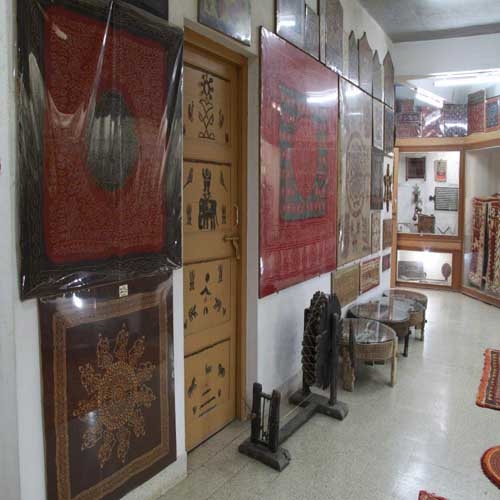
Behind the Ram Dhun Temple, the Ramkund well is a square stepwell, 56 feet on a side, with sculptures portraying characters from the Ramayana, such as Lord Ram, Devi Sita, Lakshman and Lord Hanuman, as well as the ten incarnations of Lord Vishnu along the walls. On your walk down to the water you experience a sudden calm and coolness not to be found on the road above and in the quiet, you can pause for a while to reflect on your experiences.


Royal Chhatardis are the royal cenotaphs (memorials to those not actually buried there and, in this case, not buried at all but cremated). Many of the monuments are in ruins due to earthquakes, but those of Lakhpatji, Raydhanji II and Desarji are still quite intact. The site is very quiet, out in the middle of a field, not surrounded by buildings, and is very peaceful in morning or evening, though in the middle of the day it can be quite hot under bright sun.




Sharad Baug Palace was the king's residence right up to 1991 when the last king of Kutch, Madansingh died, the palace is now a museum. With beautiful gardens of many flowering and medicinal plants, the palace grounds houses many migrating birds as they stop for a rest on their way.

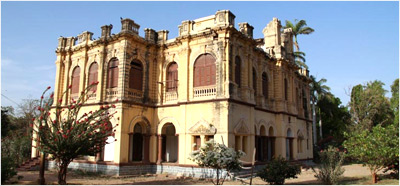


Hamirsar Lake is an excellent place to cool off on a hot afternoon.Walking along the lake's edge is a great way to get from one place to another, with the Aina Mahal and Praga Mahal, the Kutch Museum, the Ramkund Stepwell and Ram Dhun Temple, the Swaminarayan Temple and the Alfred High School all located very close to the eastern side of the lake; a walk from the Aina Mahal to the Swaminarayan Temple (passing all the other sites mentioned) takes about half an hour. Further around the other side of the lake is the Sharad Baug palace, and the road to the royal chhatardis.
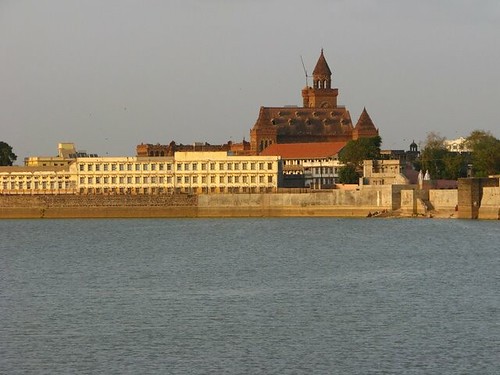
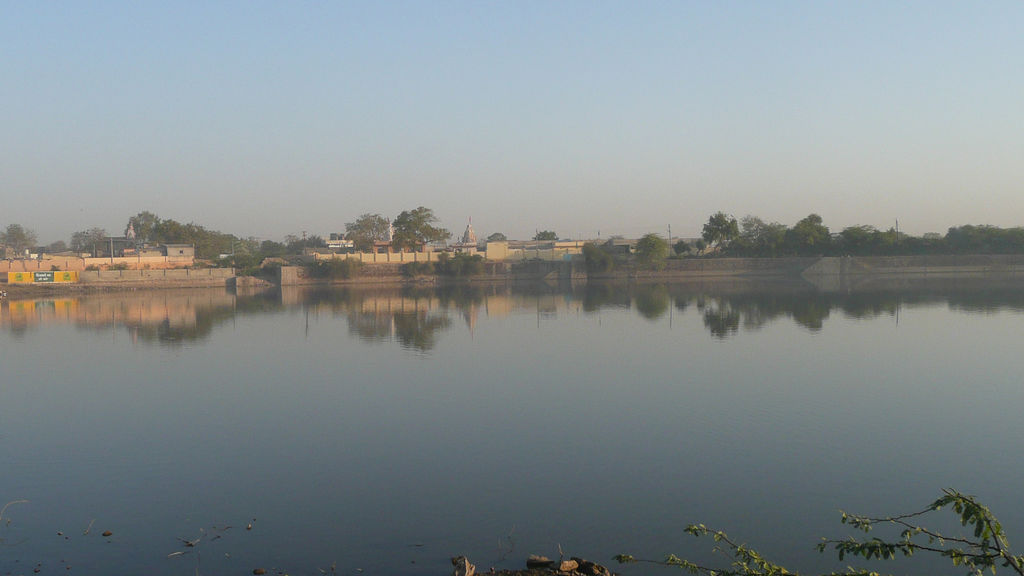

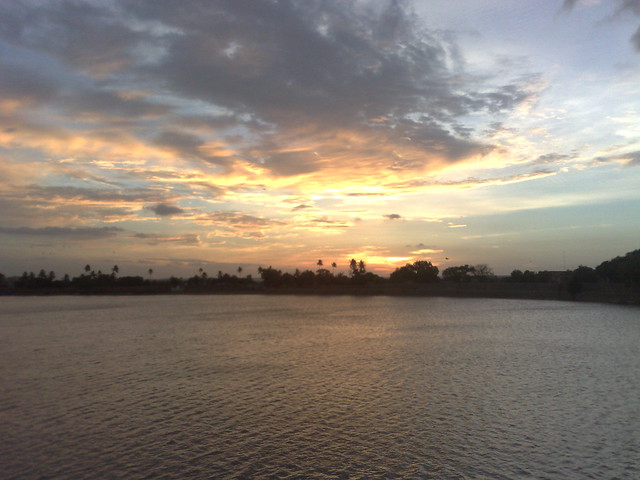
Koteshwar Temple is a place where the immensity of dry land meets the incomprehensible vastness of the sea. After so much arid ground, the sight of the ocean will awaken your spirits; though the sea is even less hospitable to humans, a sobering thought. The only point that breaks the skyline from the flat brown horizon to the east and the wide blue horizon to the west is the point of the Koteshwar Temple, the last outpost of human construction at the westernmost limit of India. Koteshwar is conducive to contemplating emptiness, pondering the place of humanity on earth.The story of Koteshwar begins with Ravana, who won a boon from Lord Shiva for an outstanding display of piety. This boon was the gift of a Shiva linga of great spiritual power, but which Ravana, in his arrogant haste, accidentally dropped and it fell to earth at Koteshwar. To punish Ravana for his carelessness, the linga turned into a thousand identical copies (some versions of the story say ten thousand, some a million; suffice to say it was quite a lot.) Unable to distinguish the original, Ravana grabbed one and departed, leaving the original one here, around which Koteshwar Temple was built.




Facing north across the Great Rann towards Pakistan, stands Lakhpat, once an important port city but now virtually abandoned for almost 200 years. A place where you can imagine the rise and decline of a great port city, and simultaneously contemplate the vast emptiness of the desert and the sea.When the 1819 earthquake sent the Indus River on its present course to the west and the Great Rann dried up, so did Lakhpat. It was left a humble town around the ruins of its former grandness, now only with Kori Creek that still flows into the Rann . Though it requires a long journey to reach Lakhpat, the intrepid traveler will be rewarded. The 7 km fort walls, erected in 1801 by Jamadar Fateh Muhammed, are still nearly intact, and offer tremendous views out over the Rann. Due to the extremely clear desert air and remote location, the night sky is spectacular (visit near the new moon for best stargazing) and sunrise or sunset in a landscape of such endless horizons are not to be missed.Lakhpat has religious significance for three of India's most populous religions: Guru Nanak, the founder of Sikhism, reportedly camped here on his journey to Mecca. The site later became a gurudwara, which holds some of Nanak's possessions; Pir Ghaus Muhammed, a Sufi mystic who from the age of twelve devoted himself to spiritual practice and reportedly practiced half as a Hindu and half as a Muslim, is buried here in Lakhpat. His tomb is a stone construction with very complex carvings and a water tank that is said to have healing properties for skin problems; Sayyed Pir Shah's nine-domed mausoleum has intricate carvings, doors, windows and jaalis.





Dated around the first century AD, Siyot Caves have an east facing sanctum and an ambulatory. Siyot must have been on of the 80 monastic sites that the 7th century Chinese travellers reported at the mouth of Indus River.


Narayan Sarovar Lake is one of the 5 holy lakes of Hinduism, along with Mansarovar in Tibet, Pampa in Karnataka, Bhubaneshwar in Orissa and Pushkar in Rajasthan. The lake is associated with a time of drought in the Puranic area, when Narayan (a form of Lord Vishnu) appeared in response to the fervent prayers of sages and touched the land with his toe, creating the lake, now revered as holy to bathe in (though this is not recommended). There are temples to Shri Trikamraiji, Laxminarayan, Govardhannathji, Dwarkanath, Adinarayan, Ranchodraiji and Laxmiji, built by the wife of Maharao Desalji.


Dholavira is the larger of the two most remarkable excavations of the Indus Valley Civilization or Harappan culture, dating back to 4500 years ago. While the other site, Lothal, is more exhaustively educated and easier to reach, a visit to Lothal only complements, rather than replaces, a visit to Dholavira. What this site offers you, in the intense environment that comes with being surrounded by the Great Rann of Kutch, is a unique insight into the pioneering Harappan mind, with one of the world’s earliest and best planned water conservation systems and what might be the world’s first signboards, written in ancient Indus script.The excavation also tells the story of the 7 stages of the civilization, from development to maturity to decay, the last of which hints at a strange piece of history, with more questions than answers. After the peak of the civilization Dholavira was temporarily abandoned, after which it seems that the settlers returned with a markedly de-urbanized culture. There are hints that they willingly chose to simplify their lives, rather than try to ride the collapse of their once glorified civilization. Here, on the ruins, you will have a chance to contemplate what progress and civilization mean and what, if anything, is truly permanent.Dholavira, known locally as Kotada (which means large fort), sprawls over 100 hectares of semi-arid land at the north-west corner of the island of Khadir, one of the islands in the Great Rann of Kutch that remain above the flood-plains in months when the rest of the desert is submerged by the monsoon. Dholavira has two seasonal nallahs, or streams: Mansar in the north, and Manhar in the south. The site was unearthed by the Archeological Survey of India (ASI) in 1967, but has been systematically excavated only since 1990. Artifacts include terracotta pottery, beads, gold and copper ornaments, seals, fish hooks, animal figurines, tools, urns, and some imported vessels that indicate trade links with lands as far away as Mesopotamia. Also found were 10 large stone inscriptions, carved in Indus Valley script, perhaps the world’s earliest signboard. These are among the most important discoveries about the Indus Valley Civilization, but remain tantalizingly undeciphered.Dholavira has one of the world’s earliest water conservation systems ever excavated. Satellite pictures show a reservoir underground, an expertly constructed rainwater harvesting system extending from the walls of the city, without which the settlement would not have thrived in the sparse rainfall of the desert.
Places to visit:
Ancient Signboard




Stadium: Stand in the middle of the stadium, close your eyes, breathe in the dry air, imagine what events might have taken place there and who might have stood at exactly that spot 4000 years ago. Move to the edge of the stadium and imagine the excitement a spectator sitting in that very seat might have felt.


Mandvi was founded as a port town by the Khengarji, the king of Kutch, in 1574. The first temple to be built was the Sundarwar temple, followed by the Jama Masjid in 1603, the Lakshminarayan Temple in 1607, the Kajivali Mosque in 1608 and the Rameshwar Temple in 1627. For all of this to have been built in the first 50 years of the towns existence is a clear indicator of its importance to the kingdom. Indeed, at its peak, Mandvi's wealth easily surpassed that of the capital at Bhuj, and it was only after ships grew too large for its harbor and began to prefer Mumbai that Mandvi started fading from the scene.For 400 years, the shipbuilding industry has been the center of life in Mandvi. It was once the principal port of Kutch and of Gujarat. At its peak, exports were said to outnumber imports fourfold, and their revenue reflected that. Ships came and went from East Africa, the Persian Gulf, the Malabar Coast (now called Kerala, in south India), and South-East Asia. During Rao Godiji's reign in the 1760's, he built and maintained a fleet of 400 ships, one that sailed as far as England and returned. The city used to have 8 m. fortified walls around it, but only small portions remain.
Places to visit:
Beaches: Mandvi Beach is the closest to the town center, across the bridge to the east side of the river.Wind Farm Beach is 7 km west of town, named for the windmills that line it to generate electricity for the area. You can get fresh coconuts and other snacks, swim in very pleasant water, and enjoy a nice view of the coastline. The Maharao's private beach, behind Vijay Vilas Palace, is 8 km from town, and requires a small fee (the other beaches are free and open to the public). More secluded than the others, the Vijay Vilas Beach has nice white sand, lovely places to swim and accommodation available in air-conditioned tents along the shore.



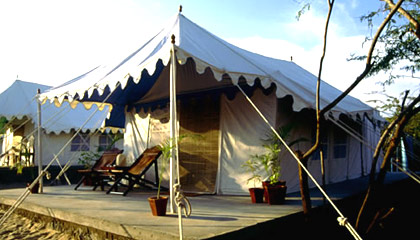
On the banks of the Rukmavati River, just south of the bridge, you can visit the still-active shipbuilding yard. Craftsmen still assemble ships out of wood, for local or international clients, and you can feel free to watch them work. If you have never seen handmade boats being built, it will make you truly appreciate craftsmanship--the process is long and elaborate and shoddy workmanship means risking sailors' lives. Boards must be painstakingly crafted, planed and fitted by hand, for a watertight fit along the long curves of the hull line. You will likely encounter legions of craftsmen working hard amidst giant piles of sawdust.


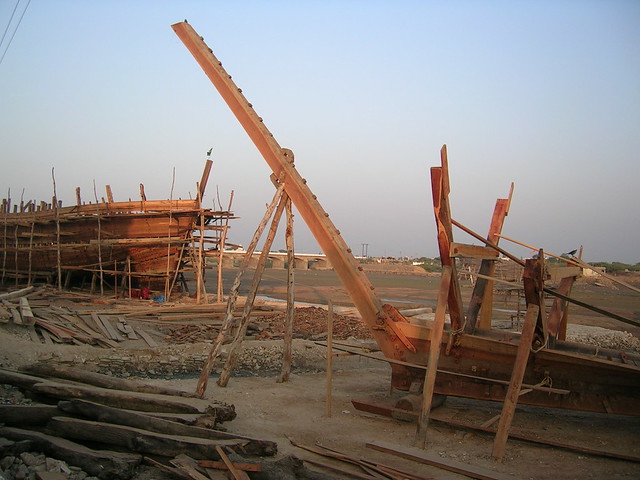
Koday houses a Jain temple complex of 72 separate shrines.



Navjivan Nature Cure Center is a healing center based on naturopathic remedies and M.K. Gandhi's ideas of “nature cure”, offers treatment for a wide variety of conditions, using everything from ayurvedic and herbal remedies to panchakarma, acupuncture, meditation, prayer, and yoga asanas. On the Bhuj-Mandvi road near Punadi Patiya village, the center also maintains 40 hectares of organic farmland on which they grow fruits, vegetables, and medicinal plants.



Mundra was well-known for salt and spice trading in the past and now more for tie-dye and block-print textiles. The harbor is virtually unusable today, and only small local fishing craft navigate its silted waterways up the river. The Mahadev temple has memorials to famous Mundra sailors, including some who advised the Sultan of Zanzibar and guided Vasco da Gama to India. Darya Pir, the patron saint of Kutchi fisherpeople, arrived here from Bukhara (now in Uzbekistan) in 1660. He was well-loved by the locals, introduced them to Islam, and they built the shrine that bears his name here when he died; this site still receives visitors of many religious backgrounds seeking blessings. The Mughal Emperor built a gate in his honor, which still stands and is known today as the Mughal Gate. Interestingly, the walls of the old city fortifications have a religious origin, as they were dragged from the ruins of the Jain city of Bhadreshwar.




Bhadreshwar is one of the major centers of Jain pilgrimage in Gujarat. Unreliable reports claim the city was founded in 516 BC, and oral accounts state that the first temple was built “2500 years ago, about 45 years after the death of Lord Mahavir,” but there is no evidence to either support or debunk that claim. The main temple is strikingly beautiful, in all white marble with majestic pillars. Around the central one are 52 smaller shrines, one of which reputedly holds the original Parshvanath idol from 500 BC Non-Jains cannot spend the night in the temple complex, but other lodging is available in town.


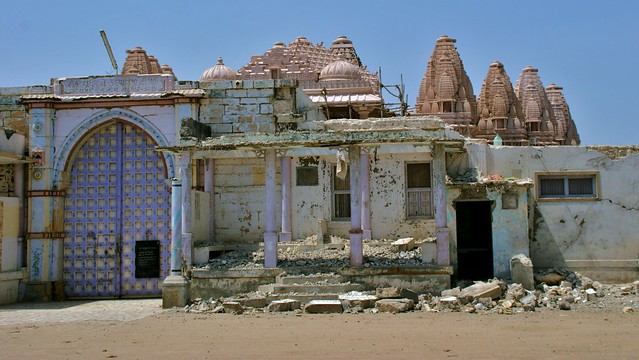

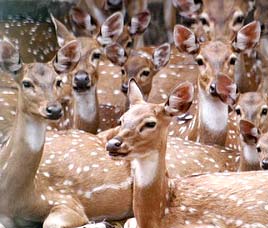
wonderful - very informative. glad you could write so comprehensively about kutch. keep it up.
ReplyDeleteLalit Bakeri - Ahmedabad.
Thanks for sharing varanasi tour operators
ReplyDelete